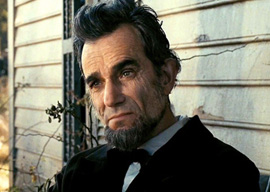
November 14, 2012

Daniel Day-Lewis
Beyond Day-Lewis’s stupendous impersonation, Lincoln is a relatively small movie. Spielberg has become a memorabilia collector in his maturity, and his new film reflects his admirable but unwieldy urge to accurately portray what all the stuff in the White House and the Capitol looked like during the last winter of the Civil War. Unfortunately, after four years of exhausting struggle, Washington was cluttered, worn down, and poorly lit. Worse, the Recent Unpleasantness marked the apogee of male facial-hair creativity. Thus, Lincoln is not a pretty sight.
All the many minor black characters in Spielberg’s movie are as noble and boring as any in a Stanley Kramer movie from a half-century ago. They are so piously dull that they make even Barack Obama seem as entertaining as Kevin Hart.
Lincoln‘s plot focuses narrowly upon the Republican Administration’s petty political maneuvers in January 1865 to persuade (i.e., bribe with postmaster jobs) enough losing Democratic Congressmen to get the House of Representatives to vote for the 13th Amendment abolishing slavery. Lincoln wanted a Constitutional Amendment to make permanent his executive Emancipation Proclamation issued on January 1, 1863 and more or less endorsed by Union voters in 1864’s elections.
Spielberg and Kushner make a couple of attempts to explain why it was so crucial for the outgoing House to pass the Amendment by Lincoln’s self-imposed deadline of January 1865 rather than merely waiting for the incoming Republican-dominated House that had been elected the previous November. But even with the superb instrument of Day-Lewis to deliver them, Lincoln’s rationalizations about how this would persuade the South to suddenly stop fighting don”t make much sense.
Wouldn”t closing off the last fond hope for a deal simply make Johnny Reb more desperate to achieve a stalemate on the battlefield? In subsequent contrast, the losing Germans in World War I tricked themselves into an early armistice in the delusional hope that Woodrow Wilson’s moderate-sounding Fourteen Points ensured them a compromise (to be negotiated later). That tactic seems less honorable than Lincoln’s, if a lot more likely to work.
The events of Lincoln begin just days after William Tecumseh Sherman had successfully concluded his March to the Sea with the capture of Savannah, Georgia on December 21, 1864. Sherman’s revolution in warfare, in which the Union began to wage war upon the Confederacy’s civilian economic infrastructure, goes unmentioned in Lincoln, even though it made possible the Congressional events depicted in the film.
The battles of 1862-63, culminating with Gettysburg (where only one civilian died), were arguably the closest the human race came to war truly being (in Churchill’s words) “cruel and magnificent.” By 1864, however, the War Between the States was turning “cruel and squalid” as both sides saw less sense in risking everything on a decisive engagement. Sherman took this logic of risk aversion the furthest, ensuring that the stronger side would win through his scorched-earth policy of waging war upon the defenseless. By the climax of Lincoln with the House vote on January 31, 1865, Sherman had begun to march north, leaving South Carolina smoldering in his wake.
The great questions at play during the Civil War were always going to be decided by force of arms, with the winner imposing his will upon the loser. The problem with a Civil War movie that features very little war in it is that the precise steps by which the politicians implemented battlefield decisions are of only modest interest, even with Daniel Day-Lewis as the star.